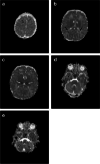Apparent diffusion coefficient values of the white matter in magnetic resonance imaging of the neonatal brain may help predict outcome in congenital cytomegalovirus infection
- PMID: 38182852
- PMCID: PMC10830666
- DOI: 10.1007/s00247-023-05838-9
Apparent diffusion coefficient values of the white matter in magnetic resonance imaging of the neonatal brain may help predict outcome in congenital cytomegalovirus infection
Abstract
Background: White matter change is a well-known abnormality in congenital cytomegalovirus (cCMV) infection, but grading remains challenging and clinical relevance unclear.
Objective: To investigate if quantitative measurement of white matter apparent diffusion coefficient (ADC) values in magnetic resonance imaging (MRI) of the neonatal brain can predict outcome in cCMV.
Materials and methods: A retrospective, single-center observational study, including patients with cCMV who had a neonatal brain MRI with diffusion-weighted imaging, was performed between 2007 and 2020. Regions of interest were systematically placed in the white matter on the ADC maps. Two pediatric radiologists independently scored additional brain abnormalities. Outcome measures were neonatal hearing and cognitive and motor development. Statistical analysis included simple and penalized elastic net regression.
Results: Neonatal brain MRI was evaluated in 255 patients (median age 21 days, 25-75 percentiles: 14-28 days, 121 male). Gyral abnormalities were noted in nine patients (3.5%), ventriculomegaly in 24 (9.4%), and subependymal cysts in 58 (22.7%). General white matter ADC was significantly higher in patients with neonatal hearing loss and cognitive and motor impairment (P< 0.05). For neonatal hearing loss, simple logistic regression using only general white matter was the best prediction model, with a receiver operating characteristic area under the curve (AUC)=0.76. For cognitive impairment, interacting elastic net regression, including other brain abnormalities and frontoparietal white matter ADC, performed best, with AUC=0.89. For motor impairment, interacting elastic net regression, including other brain abnormalities and deep anterior frontal white matter performed best, with AUC=0.73.
Conclusion: Neonatal white matter ADC was significantly higher in patients with clinical impairments. Quantitative ADC measurement may be a useful tool for predicting clinical outcome in cCMV.
Keywords: Brain; Cytomegalovirus infection; Follow-up studies; Hearing loss; Magnetic resonance imaging; Newborn; White matter.
© 2024. The Author(s).
Conflict of interest statement
None
Figures



Similar articles
-
Brain MRI findings in newborns with congenital cytomegalovirus infection: results from a large cohort study.Eur Radiol. 2021 Oct;31(10):8001-8010. doi: 10.1007/s00330-021-07776-2. Epub 2021 Mar 31. Eur Radiol. 2021. PMID: 33787973
-
Neuroimaging in infants with congenital cytomegalovirus infection and its correlation with outcome: emphasis on white matter abnormalities.Arch Dis Child Fetal Neonatal Ed. 2024 Feb 19;109(2):151-158. doi: 10.1136/archdischild-2023-325790. Arch Dis Child Fetal Neonatal Ed. 2024. PMID: 37739774 Free PMC article.
-
Brain Magnetic Resonance Imaging in Congenital Cytomegalovirus With Failed Newborn Hearing Screen.Pediatr Neurol. 2020 Sep;110:55-58. doi: 10.1016/j.pediatrneurol.2020.05.006. Epub 2020 May 20. Pediatr Neurol. 2020. PMID: 32713673 Free PMC article.
-
Diffusion-weighted MR of the brain: methodology and clinical application.Radiol Med. 2005 Mar;109(3):155-97. Radiol Med. 2005. PMID: 15775887 Review. English, Italian.
-
Understanding the impact of congenital infections and perinatal viral exposures on the developing brain using white matter magnetic resonance imaging: a scoping review.BMC Med Imaging. 2024 May 23;24(1):119. doi: 10.1186/s12880-024-01282-9. BMC Med Imaging. 2024. PMID: 38783187 Free PMC article.
Cited by
-
Congenital Cytomegalovirus Severity Definitions and Treatment Decisions around the World: A Systematic Scoping Review of the Literature.J Clin Med. 2024 Oct 8;13(19):5997. doi: 10.3390/jcm13195997. J Clin Med. 2024. PMID: 39408057 Free PMC article.
-
Neonatal Hearing Loss Risk Factors and miRNA Biomarkers Identified Through AABR Screening.J Multidiscip Healthc. 2025 May 8;18:2541-2550. doi: 10.2147/JMDH.S506757. eCollection 2025. J Multidiscip Healthc. 2025. PMID: 40357256 Free PMC article.
-
Association between White Matter T2 Hyper-Intense Signals in Fetal Brain Magnetic Resonance Imaging and Neurodevelopment of Fetuses with Cytomegalovirus Infection.Diagnostics (Basel). 2024 Apr 11;14(8):797. doi: 10.3390/diagnostics14080797. Diagnostics (Basel). 2024. PMID: 38667443 Free PMC article.
-
Congenital Cytomegalovirus-Related Hearing Loss.Audiol Res. 2024 Jun 16;14(3):507-517. doi: 10.3390/audiolres14030043. Audiol Res. 2024. PMID: 38920964 Free PMC article. Review.
-
The value of magnetic resonance imaging in congenital cytomegalovirus infection: a systematic review.Pediatr Radiol. 2024 Dec;54(13):2157-2174. doi: 10.1007/s00247-024-06051-y. Epub 2024 Oct 18. Pediatr Radiol. 2024. PMID: 39419855
References
Publication types
MeSH terms
LinkOut - more resources
Full Text Sources
Medical

